
By CHERYL ROMANO/YachatsNews.com
The City of Waldport has a fortunate dilemma.
Fortunate because it has acquired two highly visible buildings for a total price of $1.
The dilemma comes from deciding not just which local organizations get to occupy the buildings, but when and how – and also without straining the city budget.
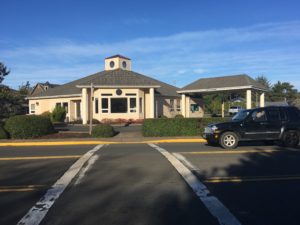
The first building to land in the city’s portfolio was the former Umpqua Bank building along Highway 34. The 3,500-square-foot structure — valued at $600,000 — became a city property for $1 last October after Umpqua closed its doors and deeded it to the city. Bank officials had met with several groups to screen potential new owners, but interest was so high it decided to give the building to the city and let them figure it out.
The latest acquisition came last week when Waldport Mayor Susan Woodruff accepted the keys to the state’s Alsea Bay Historic Interpretive Center. The striking building on the south side of the Alsea Bay Bridge was handed over by Brian Morey, district manager of the Oregon Department of Transportation.
Now, city leadership is in extended discussions to decide how the buildings will be used — and by whom. Among the possible scenarios are:
- The visitor center continues to house historic Bay Bridge displays, along with using volunteers from the Waldport Chamber of Commerce helping promote local attractions and businesses.
- The Waldport Heritage Museum, currently housed in a low-visibility building at 820 Grant St., moves into the visitor center.
- The Waldport Arts Group moves into the museum to make the building an art and cultural center.
- Finding new occupants for the Umpqua Bank building, including talk of moving city offices there.
“It’s all under discussion,” said Waldport city manager Dann Cutter, who until April was Waldport’s mayor.

Cutter did say the city plans to continue using the former bank’s drive-through window on a regular basis to handle utility payments. Beyond that, talk of City Hall moving in, or allocating new space somewhere for Central Oregon Coast Fire & Rescue, is just that — talk.
It seemed that the city’s library, which has outgrown its building on Highway 34, might be part of the mix, but Cutter said “Right now, the library is likely not to play into this” phase of moving around. “The likelihood is that the library will require building a new space at a future date,” he said.
Complicating any scenario for making a decision is the Nov. 3 election, when three council members and a new mayor will be elected to take office in January. “Come January, 50 percent of my bosses will have changed,” Cutter said. “I will present our current goals and direction, and wait to see if they (Council) decide to make the changes.”
“Right now,” Cutter stressed, “Until we actually sit down with the boards” (of Chamber of Commerce, Museum and others) “and get their thinking, nothing’s going to happen. This is a process that can take months; changes are probably not happening until early 2021.”
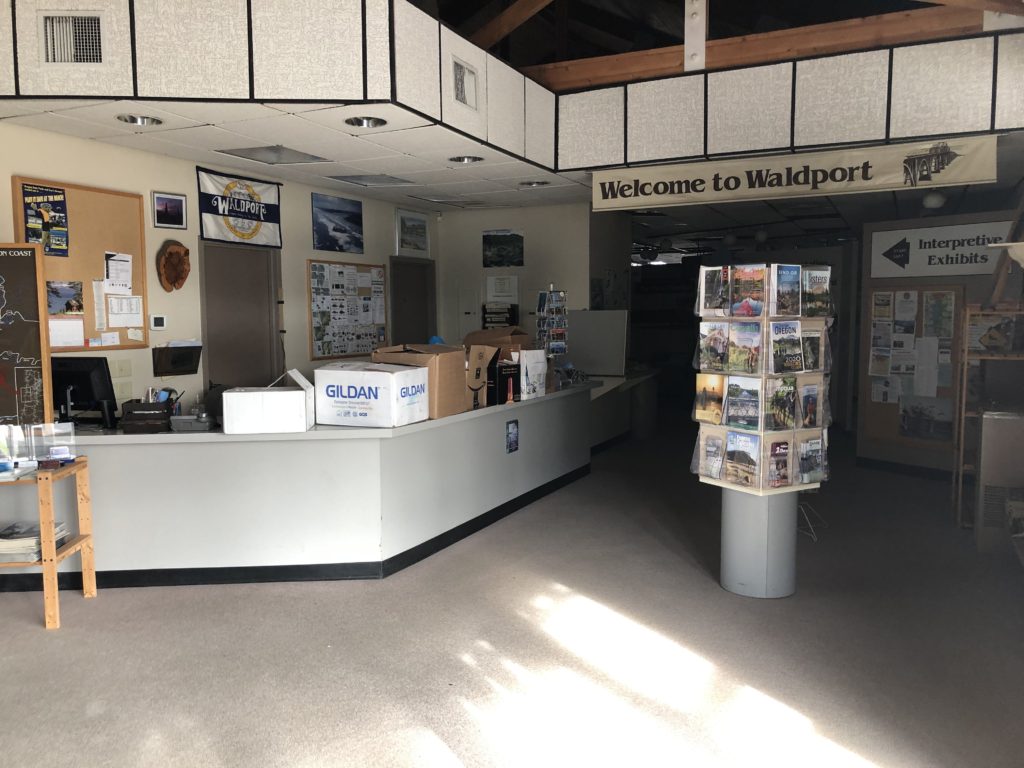
But in the near term there are plans are to re-open the visitor center, which was closed in March over pandemic concerns. “If nothing else, the interpretive center will open as before, after we do some COVID work,” Cutter said. This is expected to include Plexiglass shields for volunteers, hand sanitizer stations, and updates to the bathrooms.
The interpretive center has historic significance. It was built in 1991 when the old Alsea Bay Bridge made way for the new one on the same site. The original Conde McCullough-designed bridge was a tourist draw and constructing the center was a requirement for replacing it. The Oregon Parks and Recreation Department operated the visitor center until 2017, when Oregon Department of Transportation assumed management of the building.
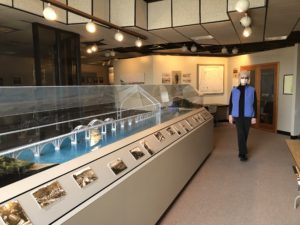
“We’ve been working with the city since then to transfer the building to the city,” said Angela Beers-Seydel, an ODOT spokeswoman. The center needed a new roof, window repairs and paint, which ODOT paid for “so it would be no cost to the city.”
Next year, ODOT plans to open a memorial kiosk on the north end of the Alsea Bay Bridge. There will be information about the bridge’s heritage, and parking for visitors so they can take in views of the bridge, the bay and the city.
The Waldport Chamber of Commerce has had a presence in the visitor center for years. Until the pandemic shutdown, the chamber conducted meetings there, and chamber volunteers helped operate the center, which has rooms of historical displays, a long replica of the old bridge, a small area to show videos, and racks of brochures and other literature for tourists.
“It’s up in the air if we’ll get to operate out of (the center),” said chamber executive director Laura Furgurson. The chamber has a site selection committee considering “different options … to see what makes sense,” she said.
Personally, Furgurson views a possible chamber home in the center as “an opportunity that’s definitely worth exploring, and obviously valuable to the city and to the chamber. The question is, what does that look like?”
There’s little question that adding the considerable collection of the Waldport Heritage Museum would make the visitor center more robust in many ways. “People would stay longer … there would be more to do … and it would increase visibility for the museum, and potentially increase business,” said Furgurson.
That increased visibility would also be a boon for the museum. “People don’t know we’re here,” said Colleen Nickerson, the museum’s president and manager of the facility on Grant Street. “If we had more traffic, we’d get more donations.”
The current structure was built by the Civilian Conservation Corps in 1941 four miles south of Waldport as a barracks for a camp for conscientious objectors. Later used by Angell Job Corps, the building was donated to the city in 1985, moved to its current site in 1988, and leased to the Alsi Historical and Genealogical Society. The museum opened to the public in 1997.
“We need people,” said Nickerson. “Right now, with all the pandemic problems, we get maybe one or two people a week.” The museum is partly funded by Lincoln County, with the remainder of expenses paid by donations and proceeds from the museum’s gift shop.
“People are shocked when they come in” and see the depth and breadth of the exhibits, said Nickerson, whose great-grandparents homesteaded on the Yachats River. Open Thursdays, Fridays and Saturdays from noon to 3 p.m., the museum focuses on the area’s indigenous people and homesteaders with displays, photos and exhibits on fishing, logging and more.
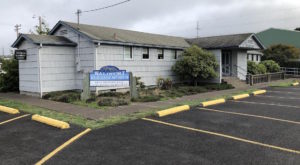
If the museum does relocate to the visitor center, Cutter foresees the museum building becoming available for cultural events. The four-year-old Waldport Arts Group is looking for a home and last year made a pitch to use the Umpqua Bank building.
“The museum has very low operational costs, which allows a potential art and cultural center to develop there without a huge burden of expense,” Cutter said. “You don’t want to dive off the deep end into a very expensive building; you want to let it grow into it. The museum space is the perfect space to let that happen.”
In turn, the museum would benefit by moving to the visitors center, Cutter said, because if fully opened, the center would have an estimated 10,000 people a year walk through its doors.
The biggest challenge of all the possible building changes? In Cutter’s view, it is making it all work without spending additional city money.
“I feel very strongly that not only should this not cost the taxpayers anything, but whatever choices we make should reduce the burden for taxpayers in the future,” he said.
The City Council will make the final decisions on the various choices now being discussed.
“Once we’ve worked out the details — and this may take several months — I’ll bring a plan to the council and let them weigh in.”
Until then, Waldport’s fortunate dilemma will play out among and between the various groups as discussions get under way.
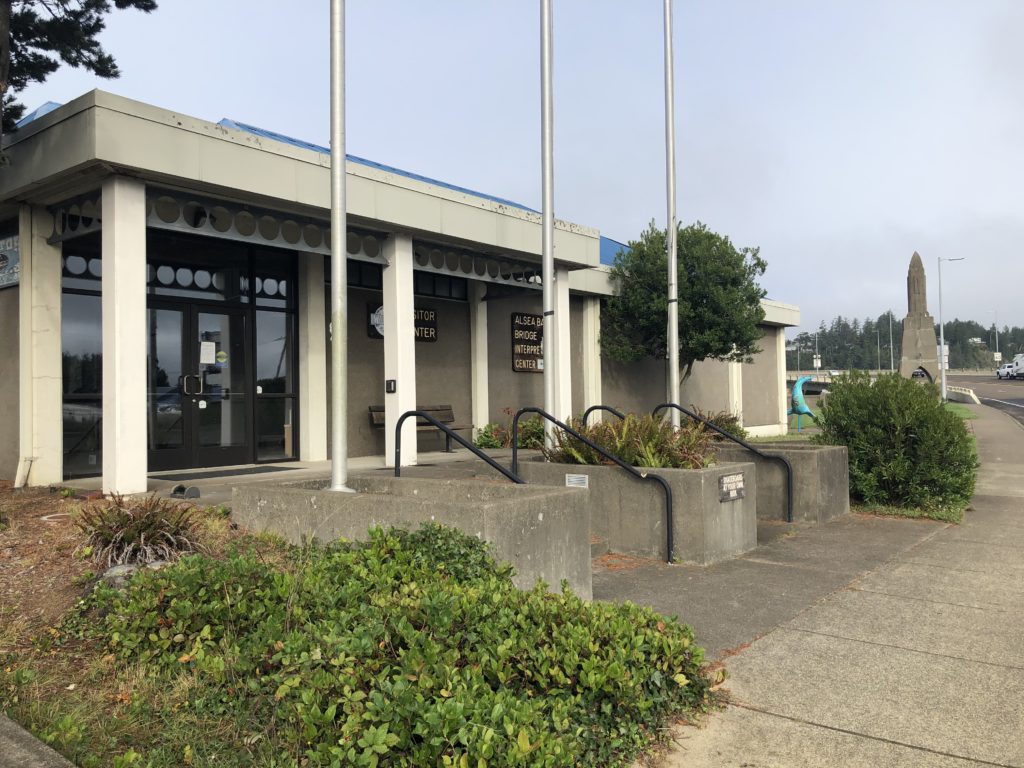



I think it is a great idea to have the Heritage Museum move to the visitor’s center. Would enable more people stopping to read about and view Waldport’s history.